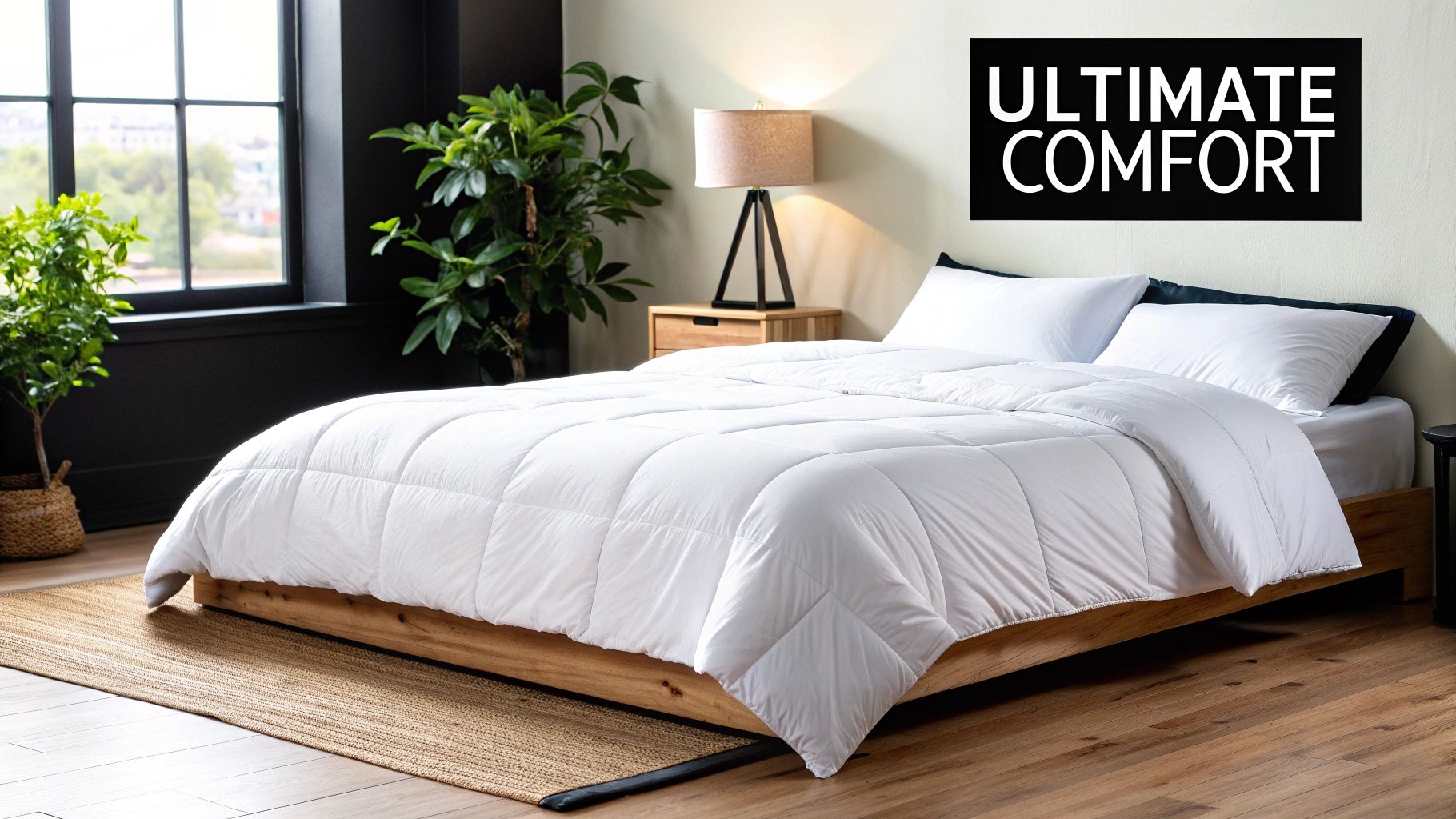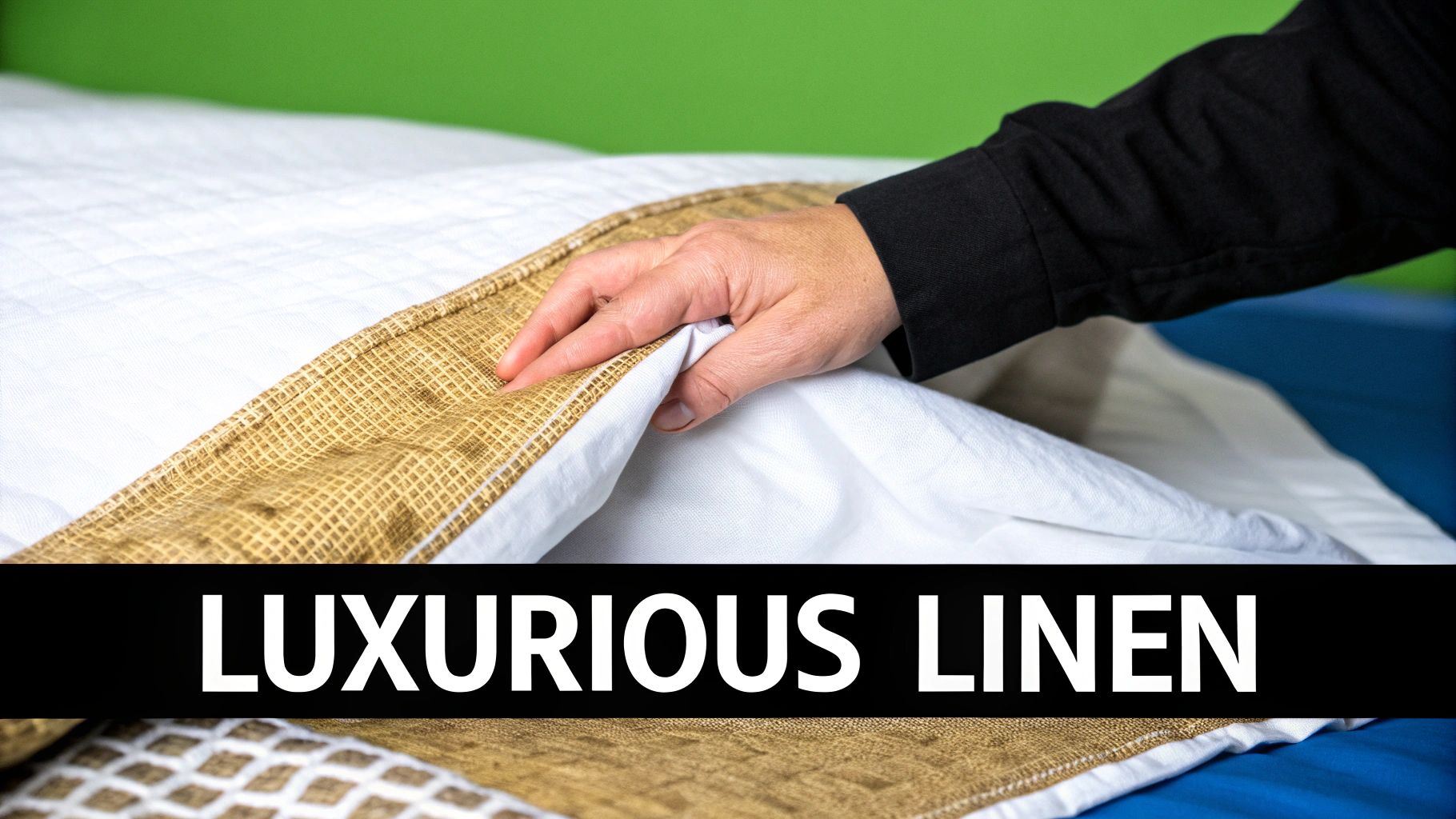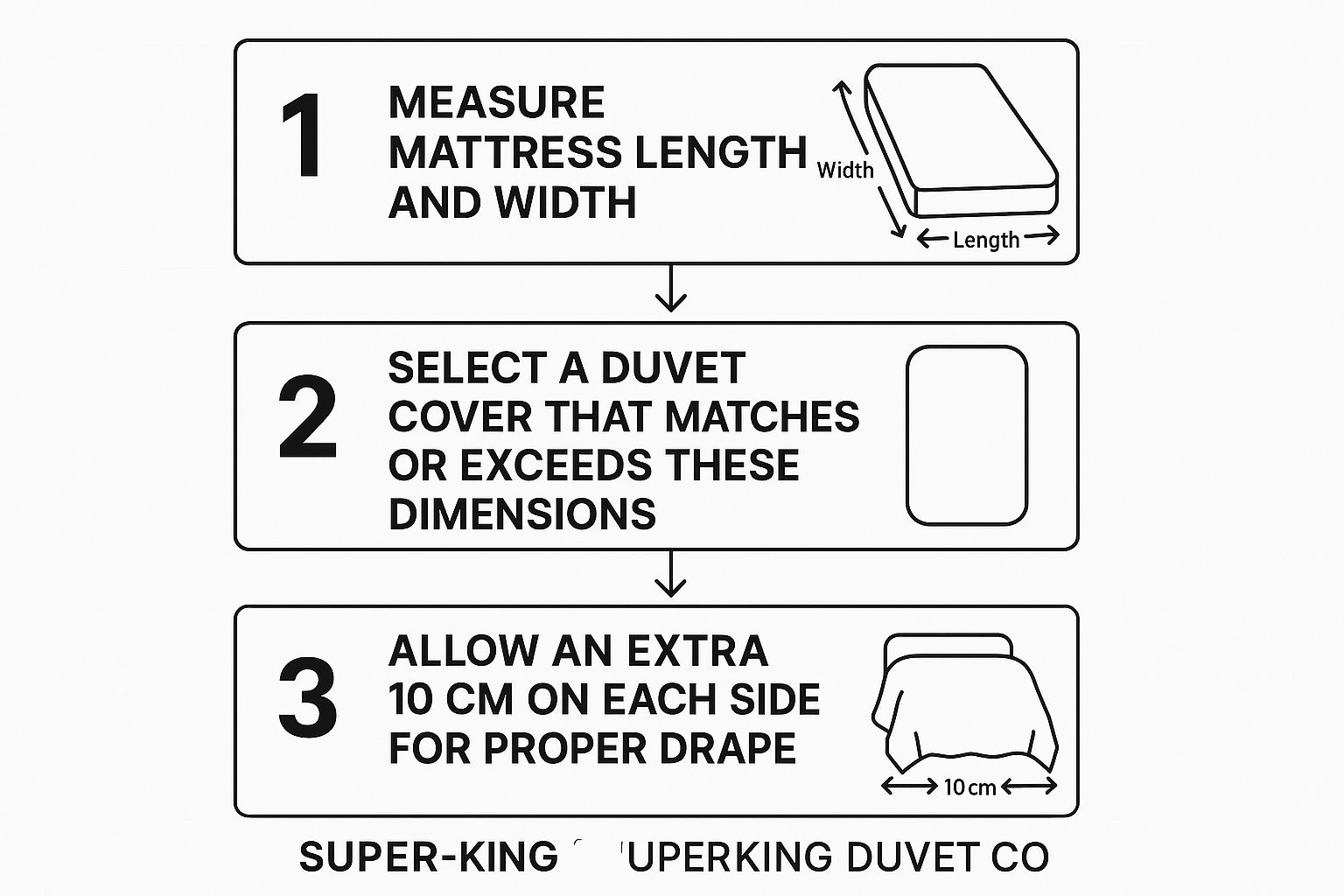Shopping for a Super King duvet cover in New Zealand can feel like a big decision. It’s more than just picking fabric—it’s about finding that perfect fit and feel to transform your bedroom into a cosy retreat.
A Super King cover drapes generously, wrapping your bed in extra warmth and style. Get it right, and your duvet becomes the centrepiece of a hotel-quality sleep haven.
Decoding NZ Super King Bedding Sizes
In New Zealand, “Super King” isn’t a marketing buzzword—it refers to a precise set of measurements for the largest standard beds. Understanding these dimensions is your first step towards avoiding ill-fitting linen that slips and bunches.
A correctly sized cover keeps the duvet inner in place, smoothing out lumps and empty corners. This consistency not only looks tidy but maintains even warmth all night long.
King Vs Super King Explained
Mixing up a standard King with a Super King can lead to floppy sides and constant straightening. Here’s what you need to know:
- Super King Duvet Cover: About 265 cm x 210 cm, giving you generous overhang for that luxe, wrapped-up feel.
- King Duvet Cover: Around 245 cm x 210 cm, which is 20 cm narrower than the Super King.
Trying a King inner with a Super King cover just won’t work—the extra fabric will flap at the edges and ruin the look you’re going for.
A well-fitted Super King duvet cover doesn’t just make your bed look inviting; it ends the nightly tug-of-war and ensures you stay snug from edge to edge.
Before you buy, measure your mattress—ideally 183 cm x 203 cm for a Super King—so every choice after that, from material to styling, feels spot on.
NZ Bedding Dimensions at a Glance
Use this quick reference to double-check sizes before you shop. It’s a handy way to confirm you’re ordering the right cover for your bed.
| Size | Mattress Dimensions (cm) | Typical Duvet Cover Dimensions (cm) |
|---|---|---|
| Super King | 183 x 203 | 265 x 210 |
| King | 153 x 203 | 245 x 210 |
| Queen | 153 x 203 | 225 x 210 |
Keep these numbers close by when browsing online or in store—it’ll save you from returns and headaches later on.
Getting the Material Right for Your Duvet Cover
The fabric touching your skin every night is a huge deal. It’s probably the single most important factor when choosing a new super king duvet cover, affecting everything from your comfort to your quality of sleep. It’s not just about picking a nice colour; it’s about finding a texture and weight that feels right for you, whether you’re a hot sleeper who needs to stay cool or someone who loves to be bundled up and cosy.
From the crisp, cool touch of percale to the relaxed, lived-in feel of pure linen, every fabric offers a totally different experience. Your choice will shape how breathable your bedding is, how soft it feels, and even how much time you'll spend on laundry day. Let's walk through the most popular options we see here in New Zealand to help you find the perfect fit.

Natural Fibres are a Game-Changer
When it comes to bedding, natural materials are almost always the top choice, and for good reason. They just feel better and breathe better. Cotton is the classic go-to, but the way it's woven makes all the difference in the world.
If you love that fresh, crisp-sheet feeling, almost like a newly ironed shirt, Cotton Percale is for you. Its simple, tight weave creates a light and airy fabric that’s fantastic for the warmer months or for anyone who tends to overheat at night.
On the other hand, if you prefer something with a silkier, smoother finish, look for Cotton Sateen. A different weaving technique gives it a beautiful, subtle sheen and a softer feel. Sateen feels a little warmer against the skin and has a lovely, luxurious drape.
I always tell people not to get too hung up on thread count. It can be a bit of a marketing gimmick. The quality of the cotton and the weave are far more important. A 300-thread-count cover made with high-quality, long-staple cotton will feel infinitely better and last much longer than a 1000-thread-count cover made from cheap, short fibres.
And then there's linen—a personal favourite and a material that seems tailor-made for the New Zealand climate. Woven from the flax plant, linen is incredibly durable and exceptionally breathable. It naturally wicks moisture away, keeping you cool and dry in summer while still feeling comfortable in winter. It has this unique, slightly textured character that just gets softer and more beautiful with every wash, creating that effortlessly chic, relaxed look. If you're intrigued by it, you can dive deeper in our guide to linen duvet covers in NZ.
Sustainable and Easy-Care Choices
As more of us Kiwis look for sustainable options, materials like organic cotton and even wool blends are becoming more popular. Wool is a brilliant natural insulator that’s also surprisingly breathable, fitting perfectly with the move towards natural, locally-minded products.
For anyone whose top priority is convenience, a cotton-polyester blend can be a really practical solution. These fabrics are known for being durable, wrinkle-resistant, and usually a bit easier on the wallet. While they don't quite offer the same level of breathability as 100% natural fibres, they're a great low-maintenance choice for a guest room, the kids' beds, or just a busy household.
Fabric Feel and Function Comparison
Choosing the right material really comes down to your own preferences and lifestyle. Do you run hot or cold? Do you love a crisp feel or a silky drape? And honestly, how much time do you want to spend doing laundry?
To make it a little easier, here’s a quick comparison of the most common materials to help you pinpoint what will work best for your bedroom.
| Material | Best For | Feel | Care Level |
|---|---|---|---|
| Cotton Percale | Hot sleepers, crisp texture lovers | Light, cool, and crisp | Medium |
| Cotton Sateen | Those seeking luxury and warmth | Silky, smooth, and drapey | Medium |
| Linen | All-season comfort, relaxed style | Breathable, textured, softens over time | Low to Medium |
| Cotton-Poly Blend | Busy households, budget-conscious shoppers | Smooth and durable | Low (wrinkle-resistant) |
Thinking through these points will help you confidently choose a super king duvet cover that not only looks incredible but actually helps you get a more restful, comfortable night's sleep. After all, your bed should be your sanctuary, and the right fabric is what makes it feel like one.
Styling Your Bedroom With The Right Cover
Your super king duvet cover isn't just bedding; it's the single largest piece of fabric in your bedroom, making it the anchor for your entire design. It’s the first thing you see in the morning and the last thing at night. The right choice can genuinely transform a room from a simple place to sleep into a sanctuary that feels completely you.
Getting this right goes beyond just picking a nice pattern off a shelf. You have to consider the room as a whole—the light, the size, and the overall vibe you're aiming for. A bold, vibrant cover might look incredible in a large, airy room, but it could easily overwhelm a smaller, cosier space.

Setting The Mood With Colour And Pattern
Colour is easily the most powerful tool for setting the tone. If you're after that serene, boutique hotel feeling, a crisp, all-white duvet cover is a classic for a reason. It feels clean and calm, and it gives you a perfect blank canvas to play with colourful cushions and throws whenever you feel like a change.
For something a bit warmer and more grounded, you can't go wrong with earthy neutrals. Think shades like oatmeal, soft grey, or a muted sage green. These colours have a natural, calming effect that makes a room feel instantly peaceful and inviting – perfect for a space dedicated to rest.
And if you want to make a statement? Go for it! A dramatic, large-scale floral print or a sharp geometric pattern can act as the main piece of art in the room. The trick is to find balance. If your super king duvet cover is the star of the show, let other elements like the curtains and rug play a supporting role with more subdued designs.
A common mistake I see is picking a pattern that’s too small for a super king bed. A tiny, fussy print just gets lost on such a big surface. You need something with presence—bolder, more expansive designs almost always work better and complement the generous scale of the bed.
Adding Depth With Texture
This is a bit of a designer’s secret weapon. Texture adds a layer of sophistication and luxury without shouting for attention. A textured duvet cover literally invites you to touch it and gives the whole bed a much richer, more interesting look.
Here are a few options that can really elevate your space:
- Waffle Weave: That lovely grid-like texture is both modern and incredibly relaxed. It adds a subtle dimension that gives the bed a casual, lived-in elegance.
- Jacquard: This is where a pattern is woven right into the fabric, creating a rich, dimensional quality. It feels classic and adds a touch of formality and depth.
- Stonewashed Linen: Beyond just being breathable and beautiful, the natural, slightly rumpled texture of linen is effortlessly chic. It looks and feels incredibly inviting.
These textures play with the light, creating subtle highlights and shadows that stop a single-colour scheme from ever feeling boring or flat.
Layering For A Polished Look
A truly beautiful bed is rarely just a duvet and a couple of pillows. Layering is what gives you that plush, magazine-worthy finish. It's a simple process that adds so much comfort and visual appeal, turning your bed into the undeniable centrepiece of the room.
Start with your sleeping pillows at the back. Then, prop a pair of large, square Euro shams in front of them. These create a full, structured backdrop that makes the bed look properly ‘dressed’. A super king can easily handle three Euro shams if you want an extra-luxe, full look.
Next comes the fun part: decorative cushions. This is your chance to introduce contrasting colours, patterns, or textures. For instance, if you have a neutral linen duvet, a couple of rich velvet or chunky knit cushions can add a completely different tactile feel.
The final touch is a throw blanket, casually draped at the foot of the bed. It breaks up the huge surface of the duvet and adds one last layer. A cosy knit throw for winter or a light cotton one for summer finishes the look perfectly. If you're stuck, we have plenty of other https://www.thefoxesden.co.nz/blogs/the-foxes-den-blog/bedroom-decor-ideas to help you bring it all together. For even more inspiration, try exploring broader home decor ideas to see how your bedding can complement the entire room.
Alright, you’ve figured out the style, material, and size you’re after for your super king duvet cover. Now for the fun part: the shopping. In New Zealand, you've got plenty of options, whether you prefer to wander through local stores or browse endless catalogues online. Both have their pros and cons, and knowing the lay of the land can make finding 'the one' a whole lot easier.
There’s something to be said for shopping in person. Being able to actually see and touch the fabric is a huge plus when you're buying something as personal as bedding. You can feel the crispness of percale versus the silky slide of sateen, see how the colour looks in natural light, and get a real sense of the fabric's weight. That hands-on experience often gives you the final nudge of confidence you need to make a decision.
Diving into Online Shopping
Of course, the internet has thrown the doors wide open for Kiwi shoppers. You’re no longer stuck with what’s in your local town; you can explore collections from all over New Zealand and even internationally, right from your couch. This is a game-changer for something specific like a super king duvet cover, as local shops might not have a huge range.
Online, you can compare prices in a flash and find a much bigger selection of designs, from understated linen looks to big, bold prints. But it’s not without its challenges. While the furniture and home bedding eCommerce market here in New Zealand is big—pulling in around USD 255 million—it has its quirks. For instance, the cart abandonment rate is a staggering 82%, which tells us a lot of people get hesitant when they can’t see the product first. Still, Kiwis are clearly keen to buy homewares online. You can get more insights into the NZ furniture and homewares market on ecdb.com.
To make online shopping work for you, really dig into the product descriptions. Go beyond just the material and look for the details that matter:
- Fabric Weight: This is often listed as grams per square metre (GSM) and gives you a clue about how heavy or light the duvet cover will feel.
- Closure Type: Is it buttons, domes, or a zip? This little detail can make a big difference to your daily life.
- Customer Reviews: This is gold. Real feedback from other buyers will tell you about the softness, if the colour is true to the photos, and how it holds up in the wash.
Your Online Buying Checklist
When you're about to click "buy" on something as important as a super king duvet cover, there are a few things you absolutely have to check to avoid any headaches later. Top of the list? The return policy. Before you even think about adding it to your cart, find it and read it.
A reputable store will give you a decent amount of time to make a return or exchange if the colour isn’t what you expected or the feel just isn't right. Be very careful with "final sale" items unless you are 100% sure it’s what you want. A good, clear return policy shows that a company trusts its products.
A quick tip: Always check the fine print on returns. Some retailers won’t cover the cost of return shipping, and for a bulky item like a super king duvet, that can add up. Knowing this from the start saves you from a nasty surprise.
It also helps to remember what goes into the price. The cost of materials like cotton can change, and then you’ve got import fees and shipping costs on top of that. Understanding this helps you see the real value in a well-made duvet cover from a trusted brand, whether it’s a global name or a beloved local NZ designer. A bit of homework now means you can shop confidently, making a smart investment in a great night's sleep for years to come.
You’ve found the perfect super king duvet cover, and now you want to keep it looking and feeling its best for years to come. With the right care, you can prevent fading, shrinking, and general wear and tear, keeping your bedding as fresh as the day you bought it.
Let's walk through exactly how to wash, dry, and handle any little mishaps so your duvet cover stays in top condition.

Washing Your Duvet Cover
The first step is always to sort your laundry. Keep colours separate to avoid any unfortunate dye transfer, especially with vibrant or dark duvet covers.
When you load it into the machine, give it plenty of room. A tightly packed drum means the water and detergent can't circulate properly. For delicate fabrics like linen, always opt for a gentle cycle with cold water to protect their beautiful texture.
A few extra tips from experience:
- Always use a mild detergent and steer clear of bleach.
- Turn the cover inside out before washing. This is a game-changer for protecting the colour and any surface details.
- Heavier fabrics, like some cotton blends, do better with a low spin speed to avoid unnecessary stress on the seams.
Drying It Just Right
There’s nothing quite like the fresh, crisp feel of line-dried bedding. Hanging your cover out in the New Zealand sun is a fantastic way to dry it naturally. The UV rays even have a mild brightening effect on whites, but don't leave it out for too long, as overexposure can weaken the fibres over time.
A crucial step: Make sure your duvet cover is completely dry before putting it away or back on the bed. Even a little dampness can lead to mildew and musty smells.
If you’re using a tumble dryer, the key is low and slow. A low heat or air-fluff setting is your best friend for preventing shrinkage. I like to pull the cover out when it's still the slightest bit damp—it makes smoothing out wrinkles by hand so much easier.
Tackling Stains
Spills happen. The trick is to act fast. Instead of rubbing, which can push the stain deeper into the fabric, gently blot the area with a clean cloth.
For oily marks, a simple paste of baking soda and water works wonders. Just apply it, let it sit for about 15 minutes, and then gently rinse before washing. Always test any new stain remover on an inconspicuous spot first, like an inside seam, just to be safe.
How Often Should You Wash It?
To keep allergens and dust mites under control, a good rule of thumb is to wash your super king duvet cover every 3 to 4 months. If you tend to sweat at night or have pets on the bed, you might want to do it a bit more often.
Having two covers to rotate between is a great strategy. It not only lightens the laundry load but also extends the life of each cover.
Storing Your Duvet Cover
When it’s not in use, store your cover in a cool, dry place like a linen cupboard. Breathable cotton bags or even an old pillowcase are perfect for protecting it from dust while still allowing air to circulate. Try to avoid plastic containers, as they can trap moisture and create an ideal environment for mildew.
Protecting Those Beautiful Colours
To keep your colours looking vibrant, always turn the cover inside out before it hits the water. A good quality, colour-safe detergent will also make a huge difference in preventing fading over time, especially for cotton and linen blends.
A couple of extra pointers:
- Double-check the care label for the maximum recommended temperature.
- For really bright colours, an extra rinse cycle can help remove any lingering dye.
- If you can, air-dry bright covers in a shaded spot to minimise fading from the sun.
A Note on Different Fabrics
Different materials need slightly different approaches.
Silky sateen weaves appreciate a gentle cycle to prevent wrinkling, while crisp percale cotton can handle a warmer wash. Pure linen is a special case; it just gets softer and more comfortable with every wash. Low-heat drying is its friend.
For more detailed guidance on looking after linen, be sure to check out our specific guide on How to Wash Linen Sheets.
Common Questions About Super King Duvets
So, you’ve picked out the perfect material and style for your new bedding. Fantastic! But even after the main decisions are made, a few practical questions often pop up right before you hit ‘buy’. Getting these final details sorted is the key to making sure your new super king duvet cover fits and feels perfect from the moment you get it home.
I've put together answers to the most common queries we get from shoppers here in New Zealand. Think of this as your final checklist to clear up any lingering doubts and make your choice with total confidence.
What Are the Standard Dimensions for a Super King Duvet Cover in NZ?
Here in New Zealand, the standard size for a super king duvet cover is 265cm x 210cm. It's designed to give you that lovely, generous drape over a standard NZ super king mattress, which typically measures about 183cm x 203cm.
That said, it’s always a smart move to measure your actual duvet inner before buying a new cover. While 265cm x 210cm is the industry standard, you can sometimes find slight variations between brands.
For a flawless fit, you want a cover that’s either the exact same size as your inner or just a couple of centimetres bigger. This tiny bit of extra room is perfect for accommodating any minor shrinkage after the first wash and lets the inner lie flat without being squashed.
Can I Use a King Duvet Inner with a Super King Cover?
It might seem like an easy way to save a bit of money or time, but I really wouldn't recommend it. A standard NZ king duvet inner is about 245cm x 210cm, which makes it a full 20cm narrower than a super king.
That size difference is going to cause you headaches. The inner will constantly shift and slide around inside the oversized cover, leaving you with empty, floppy fabric on both sides of the bed. It doesn't just look messy; it feels lumpy and creates cold spots where the duvet has bunched up in the middle.
To get that plush, hotel-quality look and feel, you absolutely need to match the size of your duvet inner to your cover. It’s an investment, but a proper super king inner is non-negotiable for a well-made bed.
How Do I Stop My Duvet from Bunching Up Inside the Cover?
Ah, the dreaded duvet bunch! It's one of the most annoying bedding problems, but thankfully, the fix is simple. The best solution by far is to look for a super king duvet cover with internal ties sewn into each of the four corners.
Most good-quality duvet inners have corresponding loops on their corners. You just tie them together, and voilà—the inner is anchored securely, preventing it from sliding down or bunching into a lump at the bottom. It's a small detail that makes a world of difference.
No ties? No problem. If your favourite cover or inner is missing them, you can easily sew small loops of ribbon onto the corners of your inner and matching ties inside the cover.
Another trick I swear by is the "burrito" or "sushi roll" method for putting the cover on. You lay the cover inside out on the bed, place the inner on top, then roll them up together before turning the cover the right way out. It sounds a bit odd, but it helps the inner sit perfectly flat and even from the get-go.
This quick visual guide shows the simple steps to get that perfect fit every time.

As you can see, starting with the right measurements and ensuring you have enough overhang are the foundational steps to a beautifully dressed bed.
Is a Super King Duvet Cover Too Big for My Washing Machine?
This is a really common and valid concern. After all, it's a lot of fabric! The good news is that most modern, standard-sized washing machines in New Zealand can handle a super king duvet cover just fine, as long as you wash it by itself. The main thing is to avoid overloading the machine.
When you put it in the wash, make sure the cover has enough room to tumble around freely. This is what allows the water and detergent to circulate properly and get it properly clean. If it looks like it's packed in too tight, your best bet is to take it to a laundromat with larger, commercial-grade machines.
A few tips for washing at home:
- Give it its own cycle: Don't be tempted to throw other sheets or towels in with it.
- Be gentle: A delicate cycle with cool or lukewarm water is best for protecting the fabric's fibres.
- Keep an eye on the balance: A single large item can sometimes unbalance the machine during the spin. If you hear loud thumping, just pause the cycle and rearrange the cover more evenly in the drum.
Follow these simple rules, and you'll have no trouble keeping your beautiful super king duvet cover fresh and clean. A little care goes a long way in making sure it stays the centrepiece of your bedroom for years to come.


